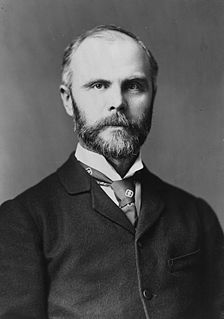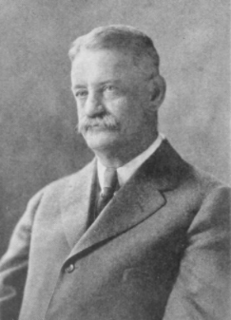William C. Edes | |
|---|---|
 | |
William C. Edes (January 14, 1856- May 25, 1922) was a U.S. civil engineer. He was the chairman and former chief engineer of the Alaskan Engineering Commission.
William C. Edes | |
|---|---|
 | |
William C. Edes (January 14, 1856- May 25, 1922) was a U.S. civil engineer. He was the chairman and former chief engineer of the Alaskan Engineering Commission.
Born in 1856 at Bolton, Massachusetts, he graduated from Massachusetts Institute of Technology in 1875 with a degree in civil engineering.
From 1878 to 1882, he was with the Southern railway on location of line through Arizona, New Mexico and Texas. From 1882 to 1886, he was in private practice, engaged in general engineering work in Boston and vicinity. He re-entered railway service in 1886, serving as assistant engineer from April, 1886, to February, 1887; he was in charge of constructing a portion of the Oregon & California railroad. He became chief assistance engineer of the San Francisco & San Joaquin Valley in 1896, and in 1901 re-entered the service of the Southern Pacific as assistant engineer, where he was engaged in locating new lines and supervising the reconstruction of other lines, including the Central Pacific from Rocklin, California, to Truckee, California until 1905, when he became district engineer maintenance of way, with headquarters at San Francisco. Edes resigned as district engineer of the Southern Pacific Co. in January 1907 to become chief engineer of the Northwestern Pacific Railroad. In 1914, he was appointed chairman of the Alaskan Engineering Commission by U.S. President Woodrow Wilson. [1] In 1919, he assumed the title of consulting engineer, a position he relinquished in March, 1920, to engage in private consulting work. [2]
He died on a train near Merced, California in 1922. Edes Lake in Alaska was named in his honor. [3]

William Barclay Parsons was an American civil engineer. He founded Parsons Brinckerhoff, one of the largest American civil engineering firms.

John Frank Stevens was an American civil engineer who built the Great Northern Railway in the United States and was chief engineer on the Panama Canal between 1905 and 1907.

Virgil Gay Bogue (1846–1916) was an American civil engineer who worked initially in his home state of New York before taking jobs internationally and in the western and northwestern United States. He primarily worked for railroads, though also became involved in city planning.

The Tehachapi Loop is a 3,779 feet long spiral, or helix, on the Union Pacific Railroad Mojave Subdivision through Tehachapi Pass, of the Tehachapi Mountains in Kern County, south-central California. The line connects Bakersfield and the San Joaquin Valley to Mojave in the Mojave Desert.

Aaron Augustus Sargent was an American journalist, lawyer, politician and diplomat. In 1878, Sargent historically introduced what would later become the 19th Amendment to the U.S. Constitution, giving women the right to vote. He was sometimes called the "Senator for the Southern Pacific Railroad".
Chief mechanical engineer and locomotive superintendent are titles applied by British, Australian, and New Zealand railway companies to the person ultimately responsible to the board of the company for the building and maintaining of the locomotives and rolling stock. In Britain, the post of locomotive superintendent was introduced in the late 1830s, and chief mechanical engineer in 1886.

Railway Age is an American trade magazine for the rail transport industry. It was founded in 1856 in Chicago and is published monthly by Simmons-Boardman Publishing Corporation.

William Phipps Blake was an American geologist, mining consultant, and educator. Among his best known contributions include being the first college trained chemist to work full-time for a United States chemical manufacturer (1850), and serving as a geologist with the Pacific Railroad Survey of the Far West (1853–1856), where he observed and detailed a theory on erosion by wind-blown sand on the geologic formations of southern California, one of his many scientific contributions. He started several western mining enterprises that were premature, including a mining magazine in the 1850s and the first school of mines in the Far West in 1864.

William Lafayette Darling (1856-1938), was a consulting engineer in St. Paul, Minnesota.

Silas Seymour was an American civil engineer and politician from New York.

Frederick C. Finkle was an American consulting engineer and geologist. He was Chief Engineer or Consulting Engineer on eighteen major dams to impound water for domestic use, power and irrigation in California and other Western States.
Benjamin Franklin Bush was an American railroad executive. At various times he served as the president of the Missouri Pacific Railroad, the St. Louis, Iron Mountain and Southern Railway, the Western Maryland Railway, the Denver and Rio Grande Western Railroad, and the Western Pacific Railroad.

The Alaskan Engineering Commission (AEC) was a U.S. Federal agency, sometimes known by its initials or by alternate spelling Alaska Engineering Commission. It was created by the Alaska Railroad Act in 1914 by U.S. President Woodrow Wilson in order to arrange for the construction of a railway system in Alaska. William C. Edes was named chairman, chief engineer Colonel Frederick Mears. In 1915, the AEC became part of the U.S. Department of the Interior. In 1923, after the railroad began operation and construction was complete, it became the Alaska Railroad Commission, later renamed to The Alaska Railroad.

Robert Brewster Stanton was a United States civil and mining engineer. He was chief engineer of an expedition investigating the Grand Canyon for a possible railroad line in 1889-90, and investigated many mining properties.

William Ashburner Cattell was a U.S. civil engineer. He served as President of the Petaluma and Santa Rosa Railroad.
Howard G. Kelley was president of Grand Trunk Pacific Railway from 1917 to 1922.
Walter Theodore Krausch, known as W.T. Krausch (1868–1929), was an American architect, engineer, and inventor who worked for the Chicago, Burlington and Quincy Railroad (CB&Q) from the late 1880s to the 1920s.
Paul Walter Kiefer was an American mechanical engineer, locomotive designer, chief engineer at New York Central Railroad, and inventor, who was awarded the 1947 ASME Medal.

James Armstrong Evans (1827-1887) was a British-born civil engineer who was part of the effort to build the Union Pacific railroad to Promontory Point, Utah in 1869. Evans was present at the Golden spike ceremony on May 10, 1869, connecting the Central Pacific and Union Pacific railroads at Promontory Summit, Utah Territory. Evans was also in the Russell photograph of the same date